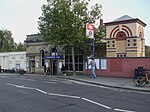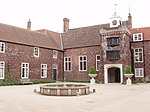Lillie Bridge Grounds

The Lillie Bridge Grounds was a sports ground on the Fulham side of West Brompton, London. It opened in 1866, coinciding with the opening of West Brompton station. It was named after the local landowner, Sir John Scott Lillie (1790–1868) and the Lillie bridge over the West London Line, that links Old Brompton Road with Lillie Road. The grounds were adjacent to the railway on the south side of Lillie Road. Although geographically near to present day Stamford Bridge, there was never direct access, there being the 13 acre now defunct Western Hospital site between the two. The ground was the scene in its day of many sports including athletics, boxing, cricket, cycling and football, and hosted the FA Cup Final in 1873. It closed in 1888 following a riot reported in The Times.
Excerpt from the Wikipedia article Lillie Bridge Grounds (License: CC BY-SA 3.0, Authors, Images).Lillie Bridge Grounds
Lillie Square, London Walham Green (London Borough of Hammersmith and Fulham)
Geographical coordinates (GPS) Address Nearby Places Show on map
Geographical coordinates (GPS)
| Latitude | Longitude |
|---|---|
| N 51.4854 ° | E -0.1943 ° |
Address
Lillie Square East
Lillie Square
SW6 1DZ London, Walham Green (London Borough of Hammersmith and Fulham, Lillie Square)
England, United Kingdom
Open on Google Maps











